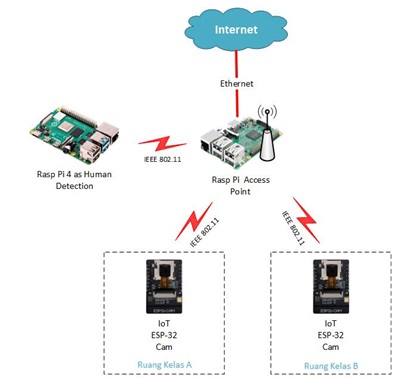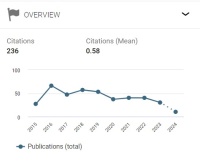Pendeteksi Jumlah Orang pada Sistem Bangunan Pintar Menggunakan Algoritma You Only Look Once
Abstract
The development of the Internet of Things today is very rapid. one form of this development is a Smart-Building or smart building. Smart buildings require a form of system that can monitor the building in real time and efficiently. in this study designed a prototype form of a smart building system by adding a detector for the number of people using the ESP32cam camera sensor. The number of people object detection adapts the careful YOLOv3 Algorithm to 5 different lighting conditions, dimmed 50% and 75%, increased 50% and 75% and normal conditions. The results of this implementation show that the mAP value exceeds 90% in all of these lighting conditions. The YOLOv3 algorithm applied to the smart building prototype system has succeeded in detecting and counting the number of people objects in an image captured by the camera sensor.
Keywords— Internet of Things; Object Detection; Smart Building; YOLO
Downloads
References
[2] Y. Bin Zikria, M. Khalil Afzal, and S. Won Kim, “Internet of multimedia things (Iomt): Opportunities, challenges and solutions,” Sensors (Switzerland), vol. 20, no. 8, 2020, doi: 10.3390/s20082334.
[3] S. Baith, N. Yadav, A. Ganvir, and P. R. Dandekar, “Wireless Multimedia Sensor Network,” Int. J. Mob. Comput. Appl., vol. 5, no. 1, pp. 9–13, 2018, doi: 10.14445/23939141/ijmca-v5i1p102.
[4] S. Wendzel, J. Tonejc, J. Kaur, and A. Kobekova, “Cyber Security of Smart Buildings 16 . 1 What Is a Smart Building ?,” 2018.
[5] D. S. Vijayan, A. L. Rose, S. Arvindan, J. Revathy, and C. Amuthadevi, “Automation systems in smart buildings: a review,” J. Ambient Intell. Humaniz. Comput., no. 0123456789, 2020, doi: 10.1007/s12652-020-02666-9.
[6] Z. Belafi, T. Hong, and A. Reith, “Smart building management vs. intuitive human control—Lessons learnt from an office building in Hungary,” Build. Simul., vol. 10, no. 6, pp. 811–828, 2017, doi: 10.1007/s12273-017-0361-4.
[7] Y. Cardinale, E. Blanco, and U. Sim, “Occupant Activity Detection in Smart Buildings : A Review.”
[8] P. Ošˇ, D. Huczala, J. Bém, and V. Krys, “applied sciences Smart Building Surveillance System as Shared Sensory System for Localization of AGVs,” pp. 1–13, 2020, doi: 10.3390/app10238452.
[9] T. Informatika and U. M. Ponorogo, “PERANCANGAN SISTEM MONITORING DAN.”
[10] H. Heikura, “Energy Saving of Central Air-Conditioning and Control System Caseb Study : Nanchang Hongkelong Supermarket.”
[11] N. K. Sabat, “An IoT Concept for Region Based Human Detection Using PIR Sensors and FRED Cloud,” 2019 IEEE 1st Int. Conf. Energy, Syst. Inf. Process., pp. 1–4, 2019.
[12] C. Wang, “Smart Cameras,” no. April, 2020.
[13] H. Hammam, A. Asyhar, S. A. Wibowo, and G. Budiman, “IMPLEMENTASI DAN ANALISIS PERFORMANSI METODE YOU ONLY LOOK ONCE ( YOLO ) SEBAGAI SENSOR PORNOGRAFI PADA VIDEO IMPLEMENTATION AND PERFORMANCE ANALYSIS OF YOU ONLY LOOK ONCE ( YOLO ) METHOD AS PORN CENSORSHIP IN VIDEO,” vol. 7, no. 2, pp. 3631–3638, 2020.
[14] C. Gde, I. Raditya, P. Adhitya, S. Dharma, and K. A. Widyatmika, “Pendeteksi Penggunaan Masker Wajah dengan ESP32 Cam Menggunakan OpenCV dan TensorFlow,” vol. 21, no. 2, pp. 155–160, 2022.
[15] C. Wang, A. Bochkovskiy, and H. M. Liao, “detectors,” pp. 1–15.
[16] P. Wu, H. Li, N. Zeng, and F. Li, “FMD-Yolo: An efficient face mask detection method for COVID-19 prevention and control in public,” Image Vis. Comput., vol. 117, p. 104341, 2022, doi: 10.1016/j.imavis.2021.104341.
[17] A. Kumar, A. Kalia, and A. Kalia, “ETL-YOLO v4: A face mask detection algorithm in era of COVID-19 pandemic,” Optik (Stuttg)., vol. 259, no. December 2021, p. 169051, 2022, doi: 10.1016/j.ijleo.2022.169051.
[18] L. Tang, T. Xie, Y. Yang, and H. Wang, “applied sciences Classroom Behavior Detection Based on Improved YOLOv5 Algorithm Combining Multi-Scale Feature Fusion and Attention Mechanism,” 2022.
[19] S. J. Ji, Q. H. Ling, and F. Han, “An improved algorithm for small object detection based on YOLO v4 and multi-scale contextual information,” Comput. Electr. Eng., vol. 105, no. November 2022, p. 108490, 2023, doi: 10.1016/j.compeleceng.2022.108490.
[20] M. Ucar, “Face Mask Detection Using YOLOv4 Face Mask Detection Using YOLOv4 YOLOv4 ile Yüz Maskesi Algılama,” no. August, 2021.
[21] C. Anirudh, “ScienceDirect ScienceDirect Deep Learning Based Automated Attendance System Deep Learning Based Automated Attendance System,” Procedia Comput. Sci., vol. 165, no. 2019, pp. 307–313, 2020, doi: 10.1016/j.procs.2020.01.045.
[22] Z. Fachmi, M. Sudarma, and L. Jasa, “Sistem Monitoring Kehadiran Perkuliahan Menggunakan Face Detection Dengan Algoritma Viola Jones,” Maj. Ilm. Teknol. Elektro, vol. 18, no. 1, p. 119, 2019, doi: 10.24843/mite.2019.v18i01.p18.
[23] R. A. Mouha, “Internet of Things ( IoT ),” pp. 77–101, 2021, doi: 10.4236/jdaip.2021.92006.
[24] Y. Yudhanto and A. Azis, Pengantar Teknologi Internet of Things. Surakarta: UNS Press, 2019.
[25] Wilianto and A. Kurniawan, “Sejarah , Cara Kerja Dan Manfaat Internet of Things,” Matrix, vol. 8, no. 2, pp. 36–41, 2018.
[26] I. P. Sudharma Yoga, G. Sukadarmika, and . L., “Dynamic Bandwidth Allocation for Internet of Things System Using Elastic Wireless Local Area Network,” J. Rekayasa Elektr., vol. 17, no. 3, pp. 162–167, 2021, doi: 10.17529/jre.v17i3.21087.
[27] B. Kerhervé, A. Pons, G. v Bochmann, and A. Hafid, “Metadata modeling for quality of service management in distributed multimedia systems,” 1st IEEE Metadata Conf., no. May 2014, 1996.
[28] D. B. Mustakima, A. Faslih, and A. Al Ikshan, “Penerapan Konsep Smart Building Pada Basement,” J. Mhs. Jur. Arsit., vol. 4, no. 2, pp. 174–184, 2019.
[29] E. Indra, M. I. Fahmi, D. R. H. Sitompul, and ..., “Desain Prototype Smart Building Menggunakan Internet of Things dengan Protokol MQTT,” J. …, vol. 5, no. April, pp. 7–10, 2022, [Online]. Available: http://jurnal.unprimdn.ac.id/index.php/JUTIKOMP/article/view/2595%0Ahttp://jurnal.unprimdn.ac.id/index.php/JUTIKOMP/article/download/2595/1643.
[30] T. Ahmad, Y. Ma, M. Yahya, B. Ahmad, S. Nazir, and A. Haq, “Object Detection through Modified YOLO Neural Network,” vol. 2020, 2020.
[31] C. Geraldy and C. Lubis, “Pendeteksian Dan Pengenalan Jenis Mobil Menggunakan Algoritma You Only Look Once Dan Convolutional Neural Network,” J. Ilmu Komput. dan Sist. Inf., vol. 8, no. 2, p. 197, 2020, doi: 10.24912/jiksi.v8i2.11495.
[32] C. N. Liunanda, S. Rostianingsih, and A. N. Purbowo, “Implementasi Algoritma YOLO pada Aplikasi Pendeteksi Senjata Tajam di Android,” J. Infra, vol. Vol 8, No., pp. 1–7, 2020.
[33] R. Padilla, W. L. Passos, S. L. Netto, and E. A. B. Silva, “A Comparative Analysis of Object Detection Metrics with a Companion Open-Source Toolkit,” 2021.
[34] “Mean Average Precision (mAP) Explained: Everything You Need to Know.” https://www.v7labs.com/blog/mean-average-precision#h1 (accessed Jan. 06, 2023).
[35] “Mean Average Precision (mAP): Definition, Metrics, and Applications in Computer Vision.” https://labelyourdata.com/articles/mean-average-precision-map (accessed Jan. 06, 2023).
[36] J. Redmon, “YOLOv3: An Incremental Improvement.”


This work is licensed under a Creative Commons Attribution-NonCommercial-NoDerivatives 4.0 International License.

This work is licensed under a Creative Commons Attribution 4.0 International License




